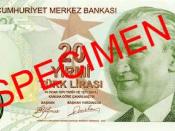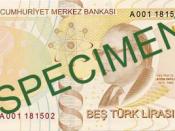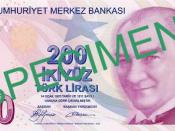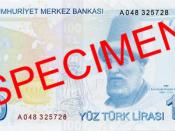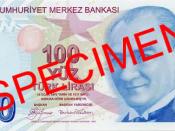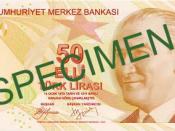Isaac Culbertson World Studies 05-20-02 Country Presentation The Formal name of Turkey is the Republic of Turkey. The Short form is of course turkey. People who live in turkey are called Turks. The Capital of turkey is Ankara. The Turkish population is about 61.2 million and steadily rising at 2.1 percent a year.
Turkey is about 779,452 sq kilometers, a little smaller than Texas and Louisiana combined. There are several natural regions that compose the topography of Turkey, Black Sea, Mediterranean Sea, Pontus and Taurus mountain ranges, Anatolian Plateau, eastern highlands, and Arabian Platform, making turkey one of the most earthquake prone regions in the world.
The Climate of turkey is cool, rainy winters and hot, moderately dry summers. The Interior, shielded from Mediterranean influences by mountains, has continental climate with cold winters and dry, hot summers. The Eastern mountainous area has inhospitable climate, with hot, extremely dry summers and bitter winters.
Rainfall varies, ranging from annual average of more than 2,500 millimeters on eastern Black Sea coast to less than 250 millimeters in central plateau area.
Turkish is the official language, spoken by most citizens; it is the mother tongue of about 82 percent of the population. Kurdish is spoken by roughly 17 percent of population. And Arabic and Caucasian languages are spoken by small minority groups. Turks constitute at least 80 percent of population; Kurds form at least 10 percent. Other minorities include Arabs, people from Caucasus countries, Dönme, Greeks, and Jews.
About 99 percent of the population is nominally Muslim, of which about 66 percent are Sunni Muslims, and about 33 percent are Alevi (Shia) Muslims. Constitution proclaims Turkey secular nation.
The Education is steadily increasing enrollments in tuition-free schools, universities, and numerous technical institutes. Middle and high schools offer academic, technical, and vocational education. Twenty-seven public universities form core of higher education system. In 1990 literacy was above 81 percent for people over fifteen years of age.
Inadequate sewer systems in some urban areas and poor water supplies in many villages pose continuing health threats, but major infectious diseases are under control. The life expectancy in (1992) was: males, sixty-eight years; females, seventy-two years; and the infant mortality ratio were fifty-five per 1,000 births.
Wheat and barley are the main crops of Turkey; also cotton, sugar beets, hazelnuts, and tobacco are major cash crops. Livestock production is very extensive and growing. Valuable forest areas are poorly managed; and fisheries are underdeveloped.
Main imports included machinery and equipment, 60 percent; petroleum, 8.5 percent; and foodstuffs, 4 percent.
The main exports consist of manufactured goods (mainly textiles and processed leather products), 70 percent; foodstuffs, 20 percent; mineral products, 4 percent.
The main trading partners are mostly industrialized countries, especially members of European Union, United States, Russia, and Saudi Arabia.
The Currency is the Turkish lira, and 1 Turkish lira (TL) = 100 kurus; (August 31, 1995) US$1.00 = TL47, 963.00.
The government is consisted of many different sections; Democratic, secular, and parliamentary, according to provisions of 1982 constitution. The government was divided into legislative, executive, and judicial establishments, with legislative power vested in unicameral National Assembly consisting of 450 deputies elected every five years.
